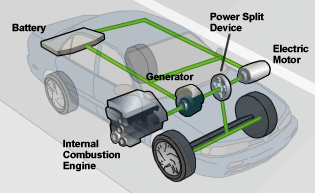How Hybrids Work
Hybrid electric vehicles (HEVs) combine the benefits of gasoline engines and electric motors. They can be designed to meet different goals, such as better fuel economy or more power.
Most hybrids use several advanced technologies:
- Regenerative Braking. Regenerative braking recaptures energy normally lost during coasting or braking. It uses the forward motion of the wheels to turn the motor. This generates electricity and helps slow the vehicle.
- Electric Motor Drive/Assist. The electric motor provides power to assist the engine in accelerating, passing, or hill climbing. This allows a smaller, more-efficient engine to be used. In some hybrids, the electric motor alone propels the vehicle at low speeds, where gasoline engines are least efficient.
- Automatic Stop/Start. Automatically shuts off the engine when the vehicle comes to a stop and restarts it when the accelerator is pressed. This reduces wasted energy from idling.
For hybrid fuel economy estimates, please visit Compare Side-by-Side.



